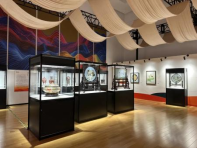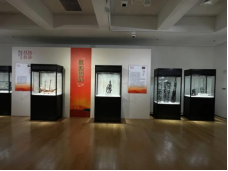Intangible Cultural Heritage Exhibition held in 2024 China (Langfang) International Economic and Trade Fair
The Silk Road Treasure: Intangible Cultural Heritage Exhibition opened at the Silk Road International Art Exchange Center in Langfang city of North China's Hebei province on June 14.
The thematic exhibition was one of sub-events of the 2024 China (Langfang) International Economic and Trade Fair, held in Langfang from June 16 to 20. It was hosted by the Langfang Municipal Committee of the Communist Party of China (CPC), the Langfang Municipal People's Government and Bauhinia Culture Holdings Limited, and undertaken by the Administrative Committee of Langfang Economic and Technological Development Zone as well as China Arts and Entertainment Group under the support of the Publicity Department of Langfang Municipal CPC Committee and Langfang Municipal Bureau of Commerce.
The exhibition event was jointly executed by China International Art Exhibition Co., Ltd. and the Silk Road International Art Exchange Center.

The Silk Road was an ancient network of trade routes that connected the East and West. The extensive commerce and trade corridor was not only a bridge for the exchanges of goods but also a bond for people-to-people exchanges. It has witnessed the exchanges and mutual learning between different civilizations and fostered numerous cultural heritage items and sites with worldwide reputation.
The thematic exhibition aimed to take the building of China (Langfang) International Economic and Trade Fair into a major national hub of commerce, trade and logistics as a carrier in the exploration, inheritance and promotion of intangible cultural heritage of relevant countries along the Silk Road and in the revitalization of those cultural relics scattered throughout the history.

There were a wide range of products on display, which were made with unique concepts and exquisite craftsmanship, at the exhibition event. They showcased unique artistic creation from various cultural background and demonstrated the craftsmanship behind relevant intangible cultural heritage inheritors.
The exhibition event comprised domestic, international and VR interaction zones, which displayed about 150 sets of cultural relics from 15 countries.

In the domestic exhibition section, organizers collected a wide range of masterpieces done by several outstanding artists after the founding of the People's Republic of China (PRC). Their exhibited works were in the form of ivory carving, cloisonné, embroidery and purple clay, demonstrating extensive and profound Chinese culture as well as the pursuit of craftsmanship.
In addition, over 10 sets of classical intangible cultural heritage products, which consisted of the Eight Marvels of Yanjing, handmade kites and nut sculpture, were on display in the parallel exhibition section.

The international exhibition section brought together intangible cultural heritage products from 14 countries, which included kuwaiti wooden sailboats, Sri Lankan string puppets, Turkish ceramics, and Kenyan black-wooden carvings. There are touching stories behind each piece of them. The culture of each country is different. Those exhibited products have transcend the boundaries of time and space, narrated the brilliance and dream of the Silk Road, and shown the common aspiration of mankind for "prosperity respectively and together."
The VR interaction zone employed cutting-edge VR digital imaging technology to go beyond physical limitations of traditional exhibitions and allowed visitors to enjoy an immersive, three-dimensional and vivid travel experience.

Civilizations become colorful and rich because of exchanges and mutual learning. The Silk Road connects the past and present, illuminating the future. It is expected that the thematic exhibition will provide local people with valuable opportunities to grasp a deep understanding of Chinese and international intangible cultural heritage.

